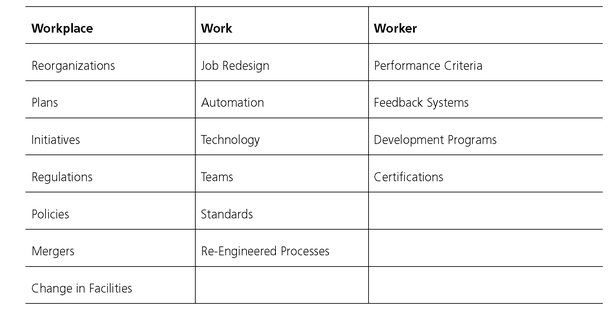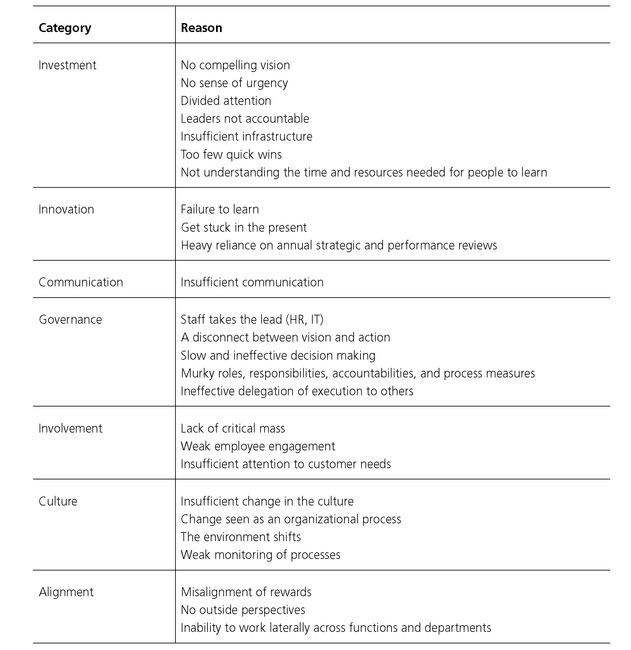IMPLEMENTATION DEFINED
Implementation means to “carry out, accomplish; especially to give practical effect to and ensure of actual fulfillment by concrete measures” (Merriam-Webster, 2003). An implementation embeds a change in behavior, systems, management practices, or relationships and includes activities before, during, and after to weave the solution into the fabric of the organization.
In practical terms, a successful implementation is as carefully designed as the change it puts in place. The implementation design includes:
• Expected results clearly linked to the business
• Extensive communication exchanges with stakeholder representatives
• Active inclusion of affected employees
• Visible support of senior management
• Identification of all affected processes
• Careful consideration of the organization’s cultural norms
When these elements are present, we can say that we have successfully built a performance improvement solution, implemented it, and integrated it into the organization.
Implementing a New Law
Some years ago, a new U.S. law, the Family Leave Act, required employers to provide time off for employees for a variety of critical family needs such as caring for a child or parent during illness. The human resources department asked us to help simplify, and make accessible to the organization’s managers, procedures for applying the law within their departments (Addison & Haig, 1999).
The materials we received were lengthy. However, the spirit of the law was favorable to employees and was likely to be helpful to many. Using our knowledge of the organization’s culture, the extensive administrative responsibilities of the managers, and the complexities of current employee leave policies and procedures we focused on reducing the size of the documents and making them easy to use. We identified the most common reasons for employees requiring leave, removed repetitive information, and combined the new law’s requirements with established company procedures to put all leave-related information in one document. This ensured that the new law’s requirements would become part of standard management practices.
Working with HR, representative managers, and the legal department, we reduced thirty-six pages to a six-page job aid using a format familiar to both HR and the managers. For scalability, the implementation plan (see Table 5.1) included both an explanatory cover letter to introduce the new law and job aid as well as a brief presentation suitable for a managers or Human Resources meeting.
TABLE 5.1. What Gets Implemented.
Source: ©2008 International Society for Performance Improvement. Used with permission.

From Episodic to Systemic Implementation
Generally, there are two kinds of implementation: episodic and systemic. An episodic implementation plan is designed against symptoms rather than drivers/causes. Such implementations are unmoored. That is, they have goals, but these are not tethered to those of the larger organization and so cannot be sustained. Weary employees recognize this as an example of “flavor of the month” to which they respond casually, knowing that whatever-it-is will soon be history.
A systemic implementation, however, addresses root causes/drivers, is long-lasting, and is engineered to stick. This implementation is designed horizontally in the organization, and moves across functions to involve all affected workers, processes, and related aspects of organizational culture.
To produce sustained implementation of a performance improvement solution, we suggest you focus on the RSVP+ principles of performance improvement:
• Achieve sustained results by emphasizing the ends (results) rather than the means (how you get there)
• Take a systems view to ensure you include all functional areas in the organization that will be touched in any way by the solution—look sideways
• Consider the value you will add to the business with a sustained implementation of the solution—what is important to the organization to achieve and maintain, and how you can support that
• Partner with stakeholders such as clients, champions, functional representatives, and others who will be impacted by your implementation to ensure sustained adoption of the initiative
• Remember the + and implement only solutions that fit the organizational norms and that the culture will embrace
Implementation Failure Versus Implementation Success
A failed implementation is easy to recognize according to the VitalSmarts/Concors Group study cited earlier (Silence Fails, 2006). It may be characterized by:
1. Fact-Free Planning. A project is set up with deadlines or resource limits that are disconnected from reality.
2. AWOL Sponsors. A sponsor fails to provide leadership, political power, time, or energy to help a project through to completion.
3. Skirting. People work around the priority-setting process.
4. Project Chicken. Team leaders and members don’t say there are problems with a project but wait for someone else to speak up.
5. Team Failures. Team members are unwilling or unable to support the project and feed into dysfunctional behavior.
Do these look familiar? As performance improvement consultants, we are uniquely positioned to help craft carefully thought-out, sticky implementation plans. We can ensure that implementations include the RSVP+ principles and link to the goals driving the organization. We can help implement in ways that match how the organization operates. As Harold Stolovitch reminds us:
“Our professional duties require us to lay aside preconceived notions, especially in unfamiliar settings. Our job is to observe, gather credible information and test-retest our perceptions before we draw conclusions or make performance improvement decisions”
Source: Stolovitch, Harold. (2008). Talent Management, 4(5), 10.
Some reasons for the failure of implementation are shown in Table 5.2.
TABLE 5.2. Reasons for Implementation Failure and Derailment.
Source: ©2008 International Society for Performance Improvement. Used with permission.

Both the design and plan for the implementation should be systemic—inclusive of all involved functions on all three levels of the organization. Specify a planned “shelf life” for the initiative and select checkpoints for review and revision to keep pace with other organizational priorities. To increase the odds of success, Judith Hale offers Ten Steps to Successful Implementation.
Ten Steps to Successful Implementation
1. Agree on the goals, scope, and measures
2. Set the baseline
3. Assess feasibility
4. Develop an implementation game plan to actualize the goal
5. Identify leading and lagging indicators
6. Put an oversight structure in place
7. Sustain attention
8. Measure rate of adoption and report
9. Shift ownership
10. Reward adoption
©Judith Hale 2008. Used with permission.
..................Content has been hidden....................
You can't read the all page of ebook, please click here login for view all page.
